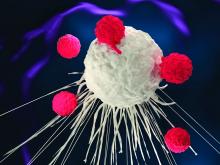ATLANTA — Chimeric antigen receptor, results of the phase 3 ZUMA-7 and TRANSFORM trials suggest.
In the ZUMA-7 trial, at a median follow-up of 24.9 months, patients randomly assigned to receive CAR T-cell therapy with axicabtagene ciloleucel, or axi-cell (Yescarta) had a median event-free survival (EFS) of 8.3 months, compared with 2 months for patients randomly assigned to standard-of-care chemoimmunotherapy, reported Frederick L. Locke, MD, from the Moffitt Cancer Center in Tampa, Fla.
In TRANSFORM, comparing the CAR T construct lisocabtagene maraleucel, or liso-cel (Breyanzi) with standard-of-care second-line chemotherapy, median EFS was 10.1 months with liso-cel, compared with 2.3 months with standard of care, reported Manali Kamdar, MD, from the University of Colorado Cancer Center in Aurora.
The trials differed slightly in eligibility criteria and other details, but their overall results show great promise for improving second-line therapy for patients with relapsed or refractory LBCL, commented Laurie Sehn, MD, MPH, from the BC Cancer Centre for Lymphoid Cancer in Vancouver, Canada.
“It’s really remarkable that the results are so far in favor of the CAR T-cell therapy that I think it’s inevitable that this will become the standard of care,” Dr. Sehn commented. She was not an investigator in either of the two trials.
Dr. Sehn was speaking at a press briefing here during the annual meeting of the American Society of Hematology. The new data from the two studies were presented at oral sessions, and the results from ZUMA-7 were also simultaneously published in the New England Journal of Medicine.
“For somebody who treats patients with large B-cell lymphoma like I do, it’s incredibly frustrating when patients fail frontline therapy,” Dr. Sehn said. “We come into the second line with more chemotherapy and at higher doses to try and slam things down hard. Particularly for the patients who were enrolled in these studies, which were the worst of the worst — the patients who are either refractory to chemotherapy or relapsed relatively early, within 1 year — it’s not surprising that coming in with a novel approach and a cellular therapy that has a proven curative capacity may have outperformed coming in with more chemotherapy.”
In an interview with this news organization, Dr. Locke said that, based on the findings of the ZUMA-7 trial that he presented, it’s likely that chemotherapy in the second-line setting for relapsed/refractory LBCL will largely fall by the wayside.
The first question is to identify the patients who can tolerate CAR T-cell therapy. “We need to refer these patients to a CAR T-cell center to make that decision. That decision really can’t be made in the local oncologist’s office,” he said. “That being said, there are patients who need urgent therapy, and they may need to get second-line chemotherapy right away.”
“What we know with CAR T cells is that older patients and patients with comorbidities can get these therapies safely, so to me there is no obvious patient who can’t get CAR T-cell therapy,” he added.
Also at the briefing, Dr. Kamdar, who presented the TRANSFORM trial results, remarked that “in my opinion, this is a breakthrough therapy, which has shown superiority over standard of care, in terms of not just efficacy but also an extremely favorable safety profile,” she said at a briefing.
For patients with LBCL for whom first-line therapy has failed, chemoimmunotherapy followed by high-dose chemotherapy and autologous stem cell transplant (ASCT) has been the standard of care, but only about 25% of patients who are candidates for ASCT achieve durable remissions, Dr. Kamdar noted.
Both ZUMA-7 and TRANSFORM were designed to test whether moving CAR T-cell therapy forward into the second line could improve outcomes.


